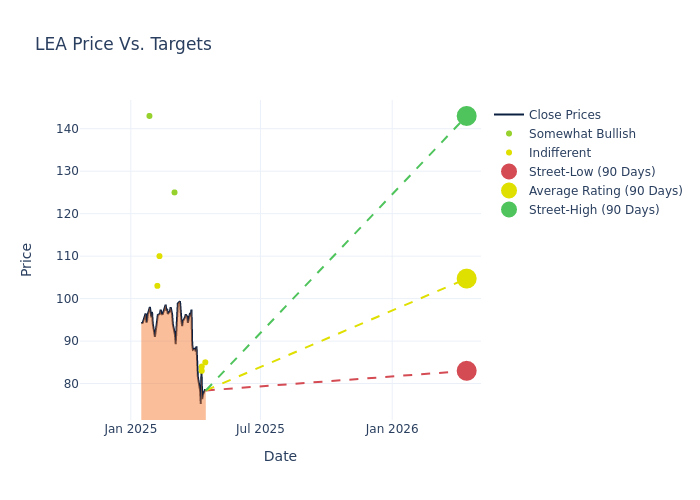
During the last three months, 9 analysts shared their evaluations of Lear (NYSE:LEA), revealing diverse outlooks from bullish to bearish.
In the table below, you'll find a summary of their recent ratings, revealing the shifting sentiments over the past 30 days and comparing them to the previous months.
| Bullish | Somewhat Bullish | Indifferent | Somewhat Bearish | Bearish | |
|---|---|---|---|---|---|
| Total Ratings | 0 | 2 | 7 | 0 | 0 |
| Last 30D | 0 | 0 | 1 | 0 | 0 |
| 1M Ago | 0 | 0 | 2 | 0 | 0 |
| 2M Ago | 0 | 1 | 0 | 0 | 0 |
| 3M Ago | 0 | 1 | 4 | 0 | 0 |
The 12-month price targets, analyzed by analysts, offer insights with an average target of $105.56, a high estimate of $143.00, and a low estimate of $83.00. Experiencing a 10.71% decline, the current average is now lower than the previous average price target of $118.22.

Decoding Analyst Ratings: A Detailed Look
The standing of Lear among financial experts is revealed through an in-depth exploration of recent analyst actions. The summary below outlines key analysts, their recent evaluations, and adjustments to ratings and price targets.
| Analyst | Analyst Firm | Action Taken | Rating |Current Price Target| Prior Price Target | |--------------------|--------------------|---------------|---------------|--------------------|--------------------| |Dan Levy |Barclays |Lowers |Equal-Weight | $85.00|$115.00 | |Joseph Spak |UBS |Lowers |Neutral | $83.00|$102.00 | |Mark Delaney |Goldman Sachs |Lowers |Neutral | $84.00|$117.00 | |Adam Jonas |Morgan Stanley |Lowers |Overweight | $125.00|$135.00 | |Chris McNally |Evercore ISI Group |Lowers |In-Line | $110.00|$125.00 | |Joseph Spak |UBS |Lowers |Neutral | $102.00|$104.00 | |Colin Langan |Wells Fargo |Raises |Equal-Weight | $103.00|$99.00 | |Ryan Brinkman |JP Morgan |Lowers |Overweight | $143.00|$147.00 | |Dan Levy |Barclays |Lowers |Equal-Weight | $115.00|$120.00 |
Key Insights:
- Action Taken: Analysts adapt their recommendations to changing market conditions and company performance. Whether they 'Maintain', 'Raise' or 'Lower' their stance, it reflects their response to recent developments related to Lear. This information provides a snapshot of how analysts perceive the current state of the company.
- Rating: Analysts assign qualitative assessments to stocks, ranging from 'Outperform' to 'Underperform'. These ratings convey the analysts' expectations for the relative performance of Lear compared to the broader market.
- Price Targets: Analysts gauge the dynamics of price targets, providing estimates for the future value of Lear's stock. This comparison reveals trends in analysts' expectations over time.
Navigating through these analyst evaluations alongside other financial indicators can contribute to a holistic understanding of Lear's market standing. Stay informed and make data-driven decisions with our Ratings Table.
Stay up to date on Lear analyst ratings.
All You Need to Know About Lear
Lear Corp designs, develops, and manufactures automotive seating and electrical systems and components. The company has two reporting segments Seating and E-Systems. Seating components include frames and mechanisms, covers (leather and woven fabric), seat heating and cooling, foam, and headrests. Automotive electrical distribution and connection systems and electronic systems include wiring harnesses, terminals and connectors, on-board battery chargers, high-voltage battery management systems. The company earns most of its revenue from the seating segment.
Financial Insights: Lear
Market Capitalization: Surpassing industry standards, the company's market capitalization asserts its dominance in terms of size, suggesting a robust market position.
Revenue Growth: Lear's revenue growth over a period of 3M has faced challenges. As of 31 December, 2024, the company experienced a revenue decline of approximately -2.17%. This indicates a decrease in the company's top-line earnings. As compared to competitors, the company encountered difficulties, with a growth rate lower than the average among peers in the Consumer Discretionary sector.
Net Margin: Lear's net margin surpasses industry standards, highlighting the company's exceptional financial performance. With an impressive 1.54% net margin, the company effectively manages costs and achieves strong profitability.
Return on Equity (ROE): Lear's financial strength is reflected in its exceptional ROE, which exceeds industry averages. With a remarkable ROE of 1.91%, the company showcases efficient use of equity capital and strong financial health.
Return on Assets (ROA): Lear's ROA excels beyond industry benchmarks, reaching 0.61%. This signifies efficient management of assets and strong financial health.
Debt Management: Lear's debt-to-equity ratio is below industry norms, indicating a sound financial structure with a ratio of 0.65.
The Basics of Analyst Ratings
Analysts are specialists within banking and financial systems that typically report for specific stocks or within defined sectors. These people research company financial statements, sit in conference calls and meetings, and speak with relevant insiders to determine what are known as analyst ratings for stocks. Typically, analysts will rate each stock once a quarter.
Analysts may enhance their evaluations by incorporating forecasts for metrics like growth estimates, earnings, and revenue, delivering additional guidance to investors. It is vital to acknowledge that, although experts in stocks and sectors, analysts are human and express their opinions when providing insights.
Which Stocks Are Analysts Recommending Now?
Benzinga Edge gives you instant access to all major analyst upgrades, downgrades, and price targets. Sort by accuracy, upside potential, and more. Click here to stay ahead of the market.
This article was generated by Benzinga's automated content engine and reviewed by an editor.